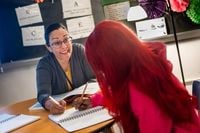Across the globe, a new urgency is driving efforts to preserve, promote, and empower linguistic diversity. From the corridors of Brashear High School in Pittsburgh to the meeting rooms of UNESCO and the digital frontiers of the African continent, advocates are rallying to ensure that every language—and every voice—has a place in our shared future.
At Washington State University, doctoral candidate Tipiziwin Tolman stands at the forefront of this movement. Recently appointed to UNESCO’s Ad-hoc Group 2 on Indigenous Language Transmission and Resilience Building, Tolman’s work is part of the Global Task Force for Making a Decade of Action for Indigenous Languages—a worldwide campaign running from 2022 to 2032. According to a statement from UNESCO, the initiative seeks to protect and revitalize Indigenous languages, recognizing them as vital to cultural diversity and human rights. Tolman, an enrolled member of the Standing Rock Sioux Tribe and a descendant of the Spirit Lake Dakota of North Dakota, brings both academic rigor and lived experience to the table.
Her research at WSU delves into Lakota and Dakota language pedagogy, literacy, and the intergenerational teachings embedded in her great-grandparents’ winter count—a traditional method of recording history. But Tolman’s influence extends beyond academia. She has organized international exchanges connecting Dakota and Lakota language communities with Māori language experts in New Zealand, developed innovative language lessons rooted in ancestral teachings, and championed a "praxis of peace" for Indigenous language teachers. This approach aims to challenge the school-to-prison pipeline by fostering supportive, culturally grounded classrooms.
“I’m honored to contribute to this global effort,” Tolman said. “Our languages carry the wisdom, laws, and lifeways of our people as learned from the land and water. This work is about ensuring that future generations inherit the strength of our ancestors’ voices.” Audrey-Maude Perreault, Secretary of the International Decade of Indigenous Languages, praised Tolman’s appointment, saying her “expertise, experience, and commitment to advancing the objectives of the Global Action Plan of IDIL2022–2032 will make an invaluable contribution to the work of the group. We are confident that her participation will enrich the collective efforts to safeguard, support, and promote Indigenous languages worldwide.”
Meanwhile, on the African continent, a different but related challenge is underway: how to ensure that Africa’s vast linguistic diversity is represented in the digital age. On October 21, 2025, the GSMA—alongside major partners like Airtel, MTN, Vodacom, and the Masakhane African Languages Hub—announced a continent-wide collaboration to develop inclusive African AI language models. The goal? To address critical gaps in data, computing power, talent, and policy so that the continent’s more than 2,000 languages are not left behind as artificial intelligence reshapes communication and commerce.
“Africa’s diversity of languages and cultures is one of our greatest strengths, yet it has too often been overlooked in the development of global AI systems,” Angela Wamola, Head of Africa at GSMA, told TechAfrica News. “This initiative is about turning that challenge into an opportunity—building African-led AI capacity, empowering innovation across local industries, and ensuring Africa shapes the digital future on its own terms. By working together, we can make AI more inclusive, more relevant, and more reflective of the world we live in.”
GSMA’s feasibility study confirmed that African-led language models are technically feasible and economically viable, but success will require collective leadership, investment, and collaboration. The initiative is setting up dedicated working groups to drive measurable progress in the areas of data, compute, talent, and policy. Partners have pledged to regularly showcase outcomes and share learnings at upcoming GSMA events, keeping the effort transparent and accountable.
The stakes are high. As GSMA’s AI for Africa report notes, most leading language models currently support only a handful of global languages, leaving billions of people whose linguistic and cultural diversity is underrepresented online. By developing AI models trained on African languages and local data, the initiative hopes to empower businesses, governments, and communities to create applications tailored to African realities—from customer service and education to healthcare and creative industries.
Back in Pittsburgh, the challenges and triumphs of linguistic diversity play out daily at Brashear High School. In October 2025, the school celebrated Hispanic Heritage Month with vibrant murals, reflecting the tapestry of its student body. With around 50 languages spoken and about 40% of its students classified as English Language Learners (ELLs), Brashear is among the most culturally diverse schools in the city.
But such diversity brings its own set of hurdles. The school has struggled with unstable leadership, inadequate staffing in its English Language Development (ELD) department, and a rise in suspensions and absenteeism. Community organizations like Casa San José and the Latino Community Center have stepped in to bridge the gap, offering enrollment assistance, translation services, mentorship, and cultural engagement programs. These organizations also help families navigate fears related to Immigration and Customs Enforcement (ICE) presence in their neighborhoods, which has led to increased truancy among some students.
Jenna Baron, executive director of ARYSE—a nonprofit serving immigrant and refugee youth—has advocated for better staffing and working conditions for ELD teachers. She emphasized the need for teachers, families, and stakeholders to play a direct role in shaping the district’s plans for new ELD centers. “Through that shared advocacy work, I’ve also come to see that the conditions for the teachers themselves are unacceptable, that they don’t feel listened to, they don’t feel like they have the resources to support their students,” Baron told PublicSource.
Despite a rapid increase in ELL enrollment (jumping to 40% in 2025-26), Brashear has not hired additional ELD teachers. The Pittsburgh Public Schools district offers internal certification programs to help teachers support English learners, but challenges remain. Principal Christina Loeffert said the school has hired teachers from diverse backgrounds outside the ELD department to help fill cultural gaps.
Leadership instability has also taken a toll. Between 2020 and 2024, Brashear cycled through four principals, complicating efforts to implement consistent school-wide initiatives. James Fogarty, executive director of A+ Schools, noted that frequent leadership changes make it difficult for schools to deliver improvements and support both staff and students effectively.
Suspension rates among ELL students have risen sharply, from 6% to 19% in the 2024-25 school year. Loeffert and her staff have responded with restorative practices, including reintegration meetings with families and violence interrupter programs in partnership with local organizations. “We have kids from all over that come to Brashear,” said Piero Medina of Casa San José. “So I think it’s just a matter of connecting everybody, so that everybody feels welcome, and we try to reduce any kind of negative situations.”
Despite these challenges, Brashear’s students and teachers find hope in their diversity. Devine Browne, a teacher of Russian and French, often uses his language skills to help students and families feel at home. Peer mentoring and informal ambassador programs have also helped newcomers adapt and thrive. As Browne puts it, “The diversity in this building—the linguistic, cultural, religious, ethnic diversity—is really a point of pride at Brashear. It’s one of the best reasons to be here as a staff person.”
From Indigenous language transmission at UNESCO to AI language models in Africa and the daily realities of a diverse American high school, the world’s linguistic tapestry is being rewoven in bold new ways—one voice, one classroom, one algorithm at a time.

